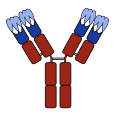 |
| Immunology |
|---|
The following outline is provided as an overview of and topical guide to immunology:
Contents
- Essence of immunology
- History of immunology
- General immunological concepts
- Components of the immune system
- Adaptive immune system
- Innate immune system
- Organs of the immune system
- Primary lymphoid organs
- Secondary lymphoid organs
- Cells of the immune system
- Myeloid cells
- Lymphoid cells
- Others
- Hematopoiesis
- Molecules of the immune system
- Immune receptors
- Antibodies
- Cytokines
- MHCs
- Complement proteins
- Antimicrobial peptides
- Transcription factors
- Signaling pathways
- Cell adhesion molecules (CAMs)
- Others
- Immune system disorders
- Hypersensitivity and Allergy
- Immunodeficiency
- Cancers of the immune system
- Myeloid diseases
- Inflammatory diseases
- Immunoproliferative immunoglobulin disorders
- Lymphatic organ disease
- Immunologic techniques and tests
- Immunology and health
- Immunologists
- Immunology lists
- References
- External links
Immunology – study of all aspects of the immune system in all organisms. [1] It deals with the physiological functioning of the immune system in states of both health and disease; malfunctions of the immune system in immunological disorders (autoimmune diseases, hypersensitivities, immune deficiency, transplant rejection); the physical, chemical and physiological characteristics of the components of the immune system in vitro, in situ, and in vivo.